
I'm tied
into that
What Selkup neighbors think about
their culture
en
The Selkups:
save as...
About
the Project
CONTEXT
TRADITIONS
TROUBLES
ver the past 15 years, the clubs of Selkup crafts have been opened, the lessons of the Selkup language have been held, and Selkup dancing groups have been created. Over the several years, the Selkups have gotten their own flag, anthem, costumes, songs, and dances. We have talked to two librarians, a teacher, an artist and a choreograph, whose work is connected with the Selkup culture. They themselves are not Selkup. We are looking for an answer to the question — why do they need it?
text:
Anastasia Tkachenko
photo:
Margarita Volokovykh, Natalia Bochkova, Alena Kardash
O
Dried fish instead of cookies; work on a book instead of vacation
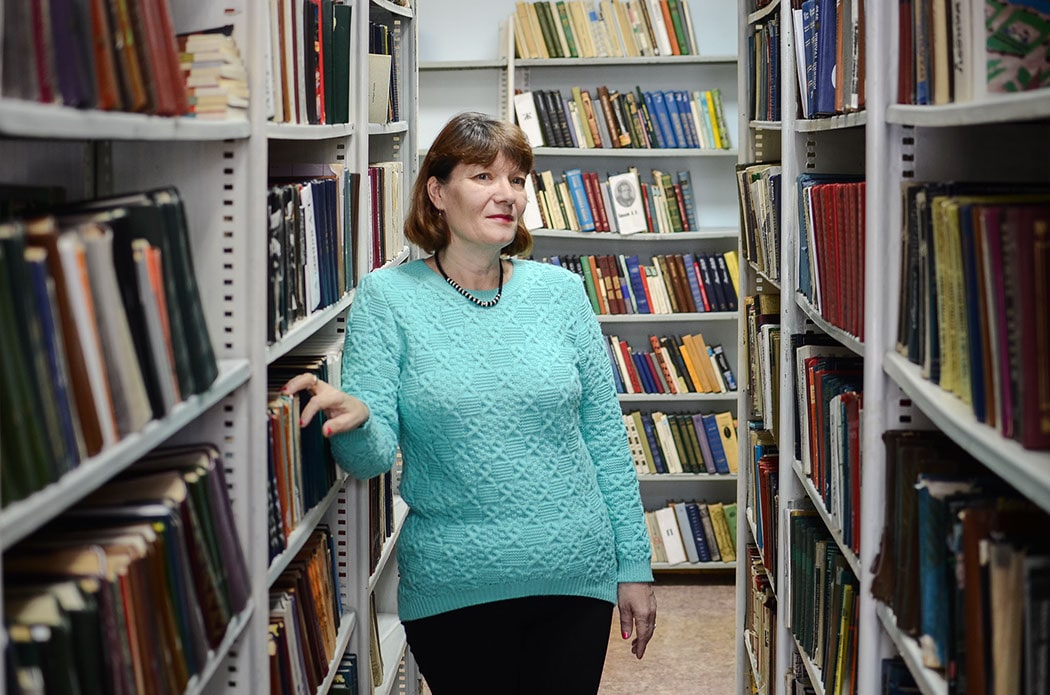
Tat'yana works in the library, and in her spare time she sings in the Selkup choir with her colleague Nina.
Tat'yana grew up in Laskino, an abandoned village now, where half of the dwellers were Selkup or Ostyak as they were used to be named. Currently, Tat'yana works in a Parabel library, and she took part in making book Ob' folk music of the Selkups of Narymskiy Krai in 2015.
The library is quiet as it is supposed to be. Bulbs are buzzing; a man is turning pages of Narymskiy Bulletin. All books in the Selkup language in the library have been found especially for me, that is, a couple of dictionaries, an A-B-C book, a storybook, and song translated into Selkup. I come to Tat'yana's table holding book "Ob' folk music".
— How many times have been this book borrowed? Roughly speaking.
— About 20 people.
— This book has been kept here since 2014, hasn't it?
— Right.
— What do you think if there were more books in Selkup, people would borrow them more often, they would be more interested in the books?
— Sure, that's for sure, — Tat'yana nods and smiles a bit.
— Is the problem that there are just a few books?
— The problem is that there's nobody to write them. Just now Irina Anatol'yevna (Irina Anatolievna Korobeynikova, an activist of the public movement of native minorities, a specialist in the Selkup culture in Parabel'skiy district, — editor's note) has written a book; she is being published in Japan, can you imagine? Though there are no more Selkups. Sorry for being rude but they are thin on the ground.
In the hall, there are eight computers in a row, a large TV set, long tables, a stack dedicated to fellow countrymen's artwork; the big letters above it say Men shall not live by bread alone. From time to time, conferences devoted to the Selkup culture and problems of indigenous ethnic groups are held at these long tables. Visitors from Tomsk and Kolpashevo come.
"Tunes of Ob’ river from the Selkups in Narymsky Krai" —
a collection of folklore tunes of Selkup and modern songs in the Narym dialect of the Selkup language, which
was heard in the Parabel
and Kargasok districts
of the Tomsk Oblast from
1962 to 2015.
We were brought up Russians. God help you if it is stated that you are Ostyak or Selkup in the birth certificate

Tat'yanalmost did not talk about working on
a book that took nearly the entire summer.
The Volost free public library was opened in the Parabel village in 1921. The library worked according to the schedule:
in March, April, June — from 2PM to 7PM. In July — from 5PM to 9PM. The library
held 596 books.
— The language is dying. People don't speak it. The culture should be not only Russian. Right now there's a festival (The Northern Etudes, editor's note): it unites not only our regions but also becomes a world-known one. People come here from Khakassia, from... what it is called...
— From Kemerovo Oblast, — Nina, the second librarian, joins the conversation, — Altayskiy krai, Yakutia...
— A lot of people come. One year there were even English, oh, no, not English but French!
— Why do the French come but the Selkups don't even tell Selkup tales to their children?
While Tat'yana is laughing, Nina shouts to me: — It's because they are Russified. They tell Russian tales.
— There are no Selkup families who would keep up the traditions. They tell fairy-tales about the Speckled Hen or Kolobok (the most common Russian fairy-tales — translator's note). Whatever roots we have, we are Russian. We were brought up Russians. God help you if it is stated that you are Ostyak or Selkup in the birth certificate. At that time, in the 70s, it was a shame.
— What about nowadays?
— Now it's high-prestige. In particular, being Selkup, not Ostyak. Recently there's been one who was proving that he's Selkup but in the passport, it is written in an old fashion that he is Ostyak. He is not allowed to get benefits because there's no Ostyak nationality. Now he's proving that he's Ostyak in court. Everybody was called Ostyaks earlier. It was used as an offensive word. My grandmother's father was Selkup, and my siblings were afraid that they would be recorded as Ostyaks. Then they got a passport and breathed a sigh of relief as they were recorded Russians, thanks God.
— Is there anything that you've learned from the Selkups and don't even realize it?
— Now all cultures have been mixed. I'm talking not only about the Russian and Selkup cultures but all of them. Take the borshch — it is Ukrainian.
— But this is Ukraine, and what about the Selkups?
Tat'yana and Nina reply in unison: — Oblaski!
— What's this?
Tatyana explains: — Oblasok is a boat made from a hollowed trunk of a tree, whose broadsides are later piled up.
We lived in Laskino where a half of inhabitants were Ostyaks. We lived all together and both the Russians and the Selkups were friends. When we visited somebody's place, we were treated with dried fish. I'm not sure if I remember this from stories or if I really have this impression. You came to the granddad, cleaned a fish from scales, and then was sitting and chewing
it on.
— Like cookies?
— Like cookies. At that time, it was better than a candy! So yummy.
Both Russian and Selkup kids were taught to catch fish. I often went fishing with my father. Once we caught such a big burbot! It was the same as catching a whale for me. "Daddy, let me take it and save it". Of course, it got frozen when we were on the way back home; it was winter.
I can help if anyone asks me to find any information about the Selkups in the library. I read a lot. For instance, I've read the tales in book Tales of Irina, a Selkup, where they are both in Russian and Selkup. Although I can't read in Selkup, it's still interesting. I sing in a Selkup ensemble; Nina also goes with me though she's not related to the Selkups.
— Does the fact that you have Selkup origins play any role?
— No. Definitely not. I didn't think of it when got engaged in all of it. It grabbed me, and people address constantly so that I can't refuse, and you get interested. That is probably the answer to the question why I work in the library: there are many books and much information. You should generally know history, not only Selkup one.
Relax back muscles,
knit the eyebrows
Aleksandra Malakhova, the head of folk dancing and singing group Varg-Kara, moved to Parabel' in October 2017. Before moving, Aleksandra had choreographed only Russian folk dances, so she had to go to the library to learn sources and create the Selkup choreography.
Among the participants of the group, there are only Russian kids and no Selkup. They are slowly moving up to the rehearsal — somebody got il,the other one helps their granny, and someone heats up the banya. They are putting on jazz shoes and boots, sitting on the benches, and talking. Aleksandra shows us certificates and clippings that are kept in a thick folder full of achievements.
— Now we're preparing for "Raduga" (which means "rainbow" in English — translator's note), a song-and-dance contest in Tomsk; we always come there with two Selkup performances.
— Have you learned the features of Selkup dancing only when you
came here?
— Yes, of course. You might say that they don't have dances. There are some basics or symbols such as birds and fish.
Seryozha, the tallest boy in the group, adds: — The pattern of behaviour.
— Yes, the behaviour pattern of animals. This is, of course, stylization. All themes are of natural occurrence. We have a dance Manzhelkula. There are also Izumba, which means wedding or Khorchegum is a successful hunt. It's all about hunting and fishing.
— Is there a difference between choreographing Russian and Selkup dances?
— The Selkup dance seems to be more animalistic.
I ask the dancers the same question. Seryozha, the tallest boy with curly dark hair and Grecian profile, replies for all of them:
— You need to try to dance a folk one, and Selkup is lazy. While dancing Selkup, you may shout "Oooh" or "Aaah", you know, these natural animal sounds.
Anastasiya continues:
— The other muscles work. You need to find something of natural occurrence in yourself for the Selkup dances. Also, the music leaves its trace. And in the Russian folk dance, you have to keep your back straight and pull legs. The Selkup dance includes more jumps. These dances are all based on jumps; your back should always be relaxed. The kids are better at the Selkup dance: they believe you may try less there. It's very difficult to organize them after that in Russian dances.
Each dance must have its meaning, its own plot, that is,
why all this is necessary.
— Do you tune yourself especially when you perform the Selkup dance?
Seryozha answers:
— We may have fun, like, you know, you're an ordinary person before a performance, and on the stage "oooh", kinda impersonation. Especially when there are disco lights. I'll try to explain it properly. When you're backstage, you are an ordinary person; but when you tune yourself and go to the stage, you feel differently. And you realize it that you should show yourself differently. The dance movements are different there, body language is aggressive, eyebrows are furrowed 'cause it's a hunt.
While the Russian dance has its school and basics, the Selkup dance is created in front of the mirror.
— When I came here, I thought that everything would be so easy. Well, actually, it’s not so. You have to go deep into the issue, get the insight into it, live and breathe images. Each dance must have its meaning, its own plot, that is why all this is necessary.
There's nothing-at-all on the internet. Even the folk doesn't have it.
For Anastasiya, the Selkup culture is only a job. It hasn't grown into immersion as a heavy load doesn't leave time, and the culture itself isn't close to her; according to Anastasiya, there's almost nothing left.
— And now you have to learn the Selkup culture.
— Yes, I do.
— Is it just an obligation or are you also interested?
— I'm interested, especially when music is composed for us. There's no Selkup music; it's specially composed for our group, and put the voices of our singers into it. She turns the music on. There's something demonic, shamanic, together with these tambourines.
— What do you think why there's so little left from the Selkup culture?
Seryozha speaks again:
— Well, that's because old people who knew the Selkup language die; urbanization continues; offsprings move to towns and are not interested in the culture. Old men can't transmit the culture to anyone and records aren't kept. That's it.
— Why are children not interested?
— They'll get older, smarter. It hasn't happened yet, that's why they don't understand anything.
— Seryozha, are you yourself keen on the Selkup culture?
— Nah, I prefer something more modern.
Art on request
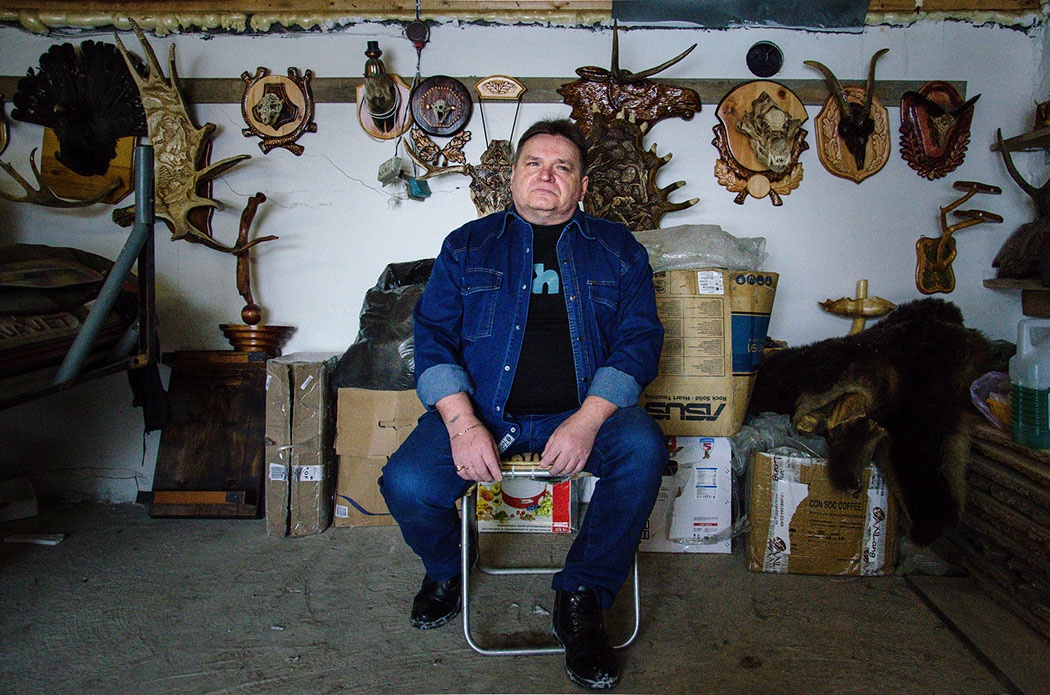
Yuri Vladimirovich is self-taught. He did not go to art school and did not like drawing in primary school, because he could not draw a nose.
Yuri Vladimirovich Fedchenko is a master of wood and bone craving and a self-taught artist. His artworks dedicated to the Selkup themes are kept in a separate vitrine as a permanent exhibition in the Centre of arts and crafts and ethnic handicrafts in Parabel'.
We've met with Yuri Vladimirovich in the museum; he's a 60-year-old man, his jacket smells faintly of paint. He didn't even look at his works and immediately started the conversation.
— I worked at the airport for some time. Then the airport was closed, and I had to do something for living as I had three children to feed. It was the period of perestroika, hard times. I was offered to hold a modeling hobby group in the art centre; so, gradually I began to work with wood. Then I was given antlers. The antlers were lying for some time, and then I decided to carve a locket; it's typical to make a locket or a rack from antlers. Then, accidentally, I saw a figure made from antlers on the internet and also decided to try, provided myself with tools. For the third year, I've been working with bone and antlers.
— Why exactly Selkup?
Yuri laughs a bit confused.
— Our district is Northern. And our local government asks us to include northern themes in art works. Not only Selkup but northern in general, different animals, for example, bears, wolves. But I don't focus only on the Selkups; I've got other works, for example, carved Putin, and works of different kinds.
— But we've come to you to talk about the Selkup culture...
— I understand it, yes. That's how they ask me to do something Selkup to present exactly Parabel' district at exhibitions; after all, we have the native Selkups. First, I was asked to do something but then you still begin to get involved. I've got a lot of works on hunting, meeting a bear. There's even a portrait of Korobeynikova; I keep it in the garage. I come up with a plot myself and build everything on it. Work with animals is very close to my heart. Although I'm a hunter, I love animals.
I go hunting and fishing. Nowadays the Selkups use modern methods; barely anyone runs with a bow. Even traps, which are traditional ways of hunting, have been changed; everything is easier now. The Selkups are also modernizing. Life goes on and change is all around us.
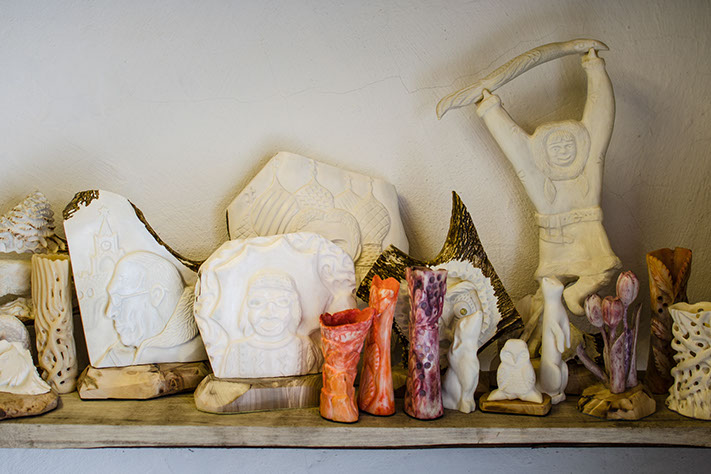
Yuri Vladimirovich likes to cut portraits on bones. To the left, there is a portrait
of Vladimir Putin on the background of the Kremlin, in front of him there is
a portrait of Irina Korobeinikova.
— Did you communicate with the Selkups when you were working on this collection?
— They helped me working with ornaments, themes, stylistic images of water, but guiding me… I can't say so, I made this all up myself. I went to the museum to get inspired. I don't want to sound offensive, but their art is in its infancy. They had a hard life, which was aimed at survival; no time for art. Of course, they made these kalavaziki (refers to qawa losi, a Selkup amulet doll for hunting, editor's note). They embroidered clothes and had some ornaments. But what I do is my vision of their culture as a vision of a modern person.
— You always know something new for yourself in such work. I already know some language, for example, what bear is or what the attitude to the
bear was.
— What attitude?
— A bear was called a younger brother or kArga. They feel deep respect for nature. When they were hunting a bear, they told it: "It's not us who killed you but Russians".
— Why is it so?
— That's because they begged forgiveness; they also wanted to ward off the wrath; that was the reason to say that it was Russians.
— Do they act the same now?
— Some of them. I haven't communicated with them, though.
Almost all Yuri Vladimirovich's works are kept in his garage. We get in the car; there's a plastic bag with tiny figures and ornaments made from antlers and bone, namely, beads, the figure of a Selkup woman in fur clothes, and several fishes.
— Rummage there, girls, maybe, you'll find something interesting there.
Yuri Vladimirovich's daughter will later take pictures of the works that are in the car to put them on sale on the internet. The works are sold out. Sometimes in the summer, a tourist boat passes Parabel'. There are foreign tourists traveling on it; a concert and an exhibition are held especially for them in Parabel'. So, Yuri's works are also in Europe now.
In the spacious garage, all shelves are loaded with Yuri's works. Among them, there are small hares and bear cubs, portraits made on wood and bone; everything that he has been creating for the past 15 years.
— Do you see yourself as a man promoting the Selkup culture?
— When we went to the fair of Northern peoples to Moscow, I was wearing a Selkup costume, a Selkup shirt. In the midst of it, you're getting engaged and become a part of this culture as if I am myself Selkup to some extent. Of course, this work impacts me.
— Do you think this culture should be revived?
— This is the primary task for the Selkups. Of course, it should be. After all, there should be the origins. It is especially important for them. I've got a feeling that the Russians need this conservation more, as some of them learn the Selkup language, become familiar with the culture, take part in amateur performances, and choreograph dances. I worked with one Selkup who was recorded as Ostyak in the passport. So I asked him: "Seryoga, do you know at least one word?" and he answers me: "No, I don't".
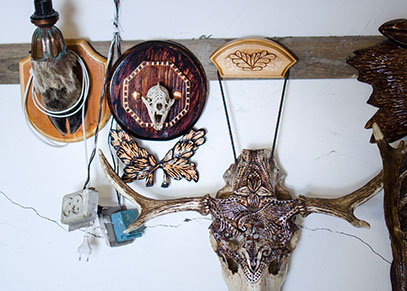
One wall of the garage is completely сovered with trophies from hunting
No ambitious goals
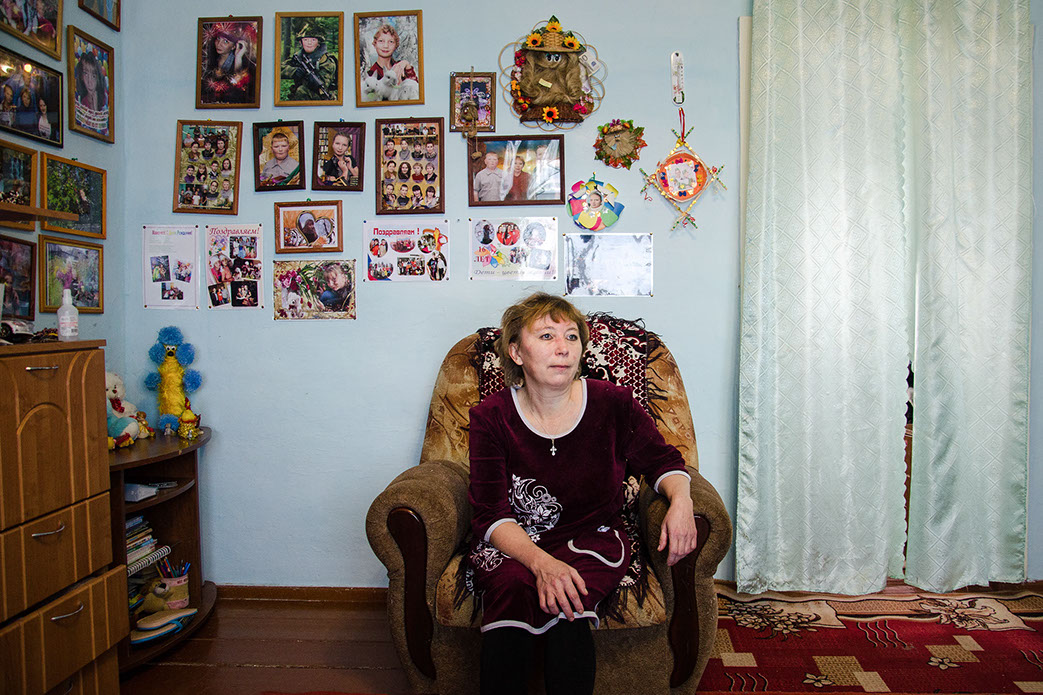
Tat'yana saves all the photos and believes in superstitions.
Tat'yana teaches Handicraft, holds school concerts and theme-based class hours (homerooms — translator’s note). One of them is a class hour devoted to the Selkup culture with costumes, candles, music, and fur twigs.
There's a neat shoe on a wooden house; later, Svetlana explains to us that she peeked the idea on the internet. A guest loses in contemplation of the shoe and doesn't have time to think ill of the owners of the house. A cat is warming itself at the stove; on the fridge, there's a magnet with the photo of the daughter in a Selkup costume.
— Oh dear, I'm so glad that somebody has come to us; now there's someone who will tell people about us, — Tat'yana takes a homemade cake out of the fridge.— My daughter, Sveta, went to the Selkup hobby group where costumes were made for them and they were taught to weave a net. By the way, my brother used to weave nets with a needle. Maybe, some of neighbours taught or he taught himself. There was just one channel on TV previously and we entertained ourselves as best we could. Children went to that hobby group, it was interesting for them and there was nowhere else to go. All children get involved when there's something new but then come less and less often. Three years in a row my Sveta went to perform at The Northern Etudes. It's good that children develop, go somewhere, learn how to communicate as it's difficult for them to sit still in a small village. Then our Selkup group was closed.
— Why?
— It's all about money. More talented move away from here. There are few Selkups left; across the road, there's a Selkup woman, my neighbour, aunt Lyuda Ipokova. When you were coming to me, I was asking her all about the Selkups and she just answered me that she knew nothing, she was too little. They've already lost their culture.
— Why is the culture getting lost?
— Well, it began long time ago. I don't know. Everybody strives for something. And the village itself is dying; just look, girls, the village is dying! Who saves the village? Nobody. And who wants to live in the village? Who wants to shovel snow? Raise a cow? Nobody wants.
My son went to throw manure and I was baking this cake. I had to make the cream using store-bought sour cream but that's not really sour cream, there's only water! So he came in and I asked him if he tried the store-bought sour cream. He answered that he did. Then I told him to throw manure and we would wait until the cow calved so that we had normal healthy sour cream.
We were sitting by candlelight and telling tales. There must be something to engage children. We've decided to get them engaged with help of culture. We sometimes just live like this without pursuing any ambitious goals.
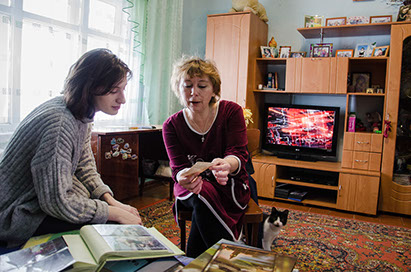
Tat'yana shows me the only picture
of her grandfather.
I've been living in Nel'mach for 25 years. I knew about the Selkups in my childhood as my aunt was married to a Selkup. Everything is mixed here.
If I didn't know that Svetlana Georgievna (Chinina, a primary school teacher, editor's note) is Selkup, I would never identify her nationality. Though everybody knows that we live with the Selkups. It has become our feature; newspapers constantly write something about us. You see, they've realized that origins are getting lost. Museums are opened, exhibitions are held, this festival, The Northern Etudes...
— Have you visited it?
— Twice. Due to the festival, tourism has been raised in Parabel'. I madly loved the first time I went there as the atmosphere was pretty awesome, performers came. Some of them were Selkup, others were Khakass, and the others were just costumed. There are not enough people to make an ensemble, that's why they begin to dress everybody up. But that's not bad, costumes are so gorgeous. When I went there for the second time, everything was more about money. You know, buying and selling, lots of stalls. Also, these things were flying, what they're called...
— Quadcopters?
— Exactly. And militia or police is everywhere; I feel so uncomfortable because of all this spying.
Tat'yana reaches out for a pile of thick family albums and Tat'yana shows a black and white photo where there are an old woman and children in costumes.
— Here is how children went to congratulate one old woman at New Year; she's Selkup. At that time all children went to the homes wearing costumes and wished everybody happy New Year. In this photo, there are my daughter and her girlfriends. They made these pendants and headbands themselves in that hobby group.
— If you don't devote yourself to history, it may die.
— What if the culture is kept in our memory but doesn't continue living?
Is it okay?
— No, it's not. We have to try. Here we are trying.
— This is me we another teacher, Margarita, who is also partly Selkup. Either it was she who offered it or it was spontaneously... All in all, we held a class hour on a Selkup topic. We brought fur twigs, sat in a circle, put on costumes, and my daughter Sveta had found some music — sounds of tambourine and throat singing; you know, I always have too many events and concerts; who will save the mother? Of course, the children. So, we went to the class, children took their places, and Margarita began to tell the tales. She makes a lot of them herself and remembers plenty of stories from her grandmother, who was Selkup. One of these tales is about a rogue bear who captured their family in a hut. We were sitting by candlelight and telling tales. There must be something to engage children. We've decided to get them engaged with help of culture. We sometimes just live like this without pursuing any ambitious goals.
Two cultures
under one roof
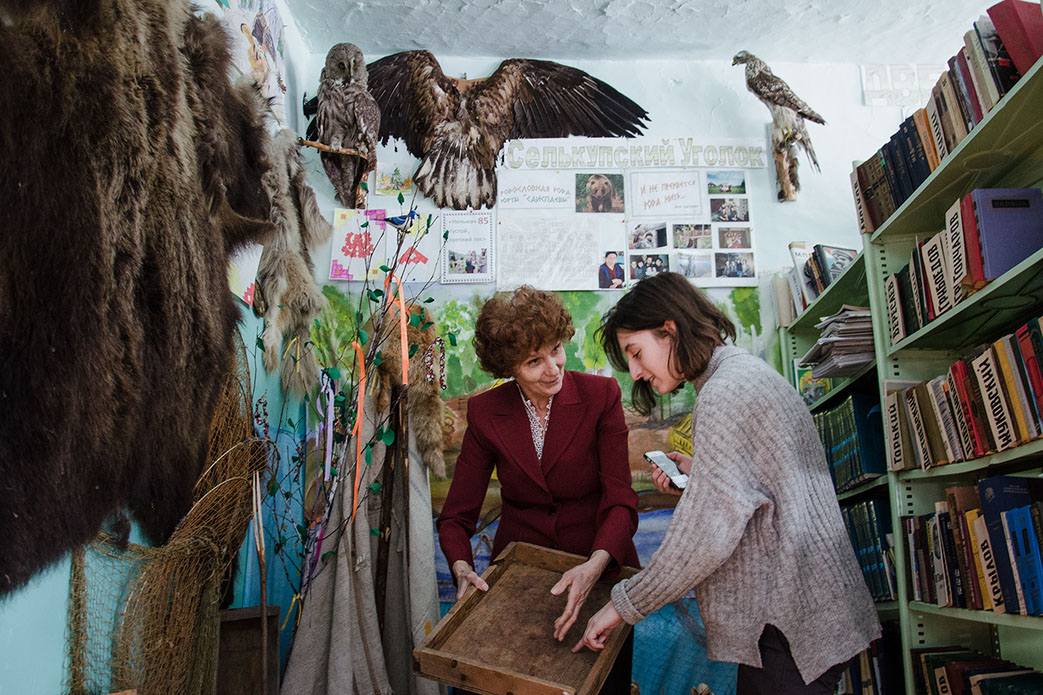
Galina Aleksandrovna shows traces of crushed berries. Almost all exhibits of the museum were used in everyday life in the past.
More info
Post-Selkups.
A monologue by Anastasia Sereda of the drama club.
A small wooden building is simultaneously shared by the library, the post-office, and the hospital. Galina Aleksandrovna, the head librarian wearing a red jacket and having red curly hair, meets us in the library consisting of the only hall. The hall is divided into two parts — there are a spinning wheel, linen hand towels, and a lawn with chicks on the one side while on the other you can see a skin of a bear, fishing nets, and a stuffed eagle, which doesn't have a head, though.
— You see what name our nook has: "Two cultures with one fate". When everybody started to think about attracting attention, I decided to organize anything in our library. The name crossed my mind and I began to improvise from it — there would be a Selkup nook and there — a Russian one. Even a Selkup fence has been constructed here but we had to remove it as the floor was collapsing. So, bit by bit, we began to gather all these things — the skin of a bear, stuffed animals.
All villagers were gathering the essential elements for the nook. Then we decided to organize a hobby group. In our dreams, children were studying Selkup but there was nobody in Nel'mach who knew Selkup. The department of culture found some money and invited Chinina Svetlana Georgievna, who is Selkup, to hold the hobby group. We named the group “Takkylymbegu negend”, which means “Come together” in Selkup. Once a week on Sunday she used to teach school students to make accessories from birch bark, hollow up oblaski, and embroider ornaments. Last year the section was closed as Svetlana Georgievna stopped being paid. Sometimes kids keep gathering together by force of habit, prepare for the festival and Holiday of Axe (the annual international festival and competition of carpenters in Tomsk — TN), where the group from Nel'mach goes for three years in a row.
— We are exotic, we are shot every year! We cook ukha there, treat everybody, tell about the customs, for example, tell how the first spoon was put into ukha, how people thanked the spirit of water, the spirit of fire. We sell books about the Selkups, hold Selkup games of accuracy. There's even a demand for us; we're called every year, we bring a whole display, and it is even announced on the radio: there will be guests from Parabel' district, Northern region. In fact, when we come, everybody tells us: "You know, we've heard nothing either about you or the Selkups".
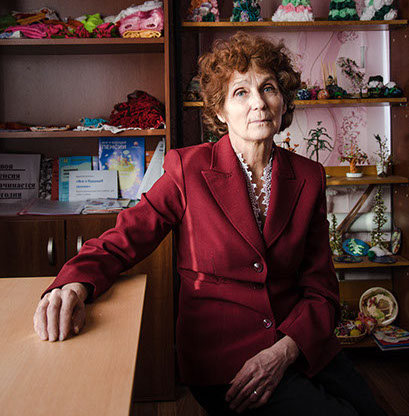
Galina Aleksandrovna is the winner of the contest "Person of the Year-2012" for the nomination "Worker of Culture, Arts
and Mass Media".
That's what people tell me all the time — how are you related to the Selkups? I'm tied into that! My grandson is Selkup! My daughter got married to a half Selkup. But that's not the point, Galina Aleksandrovna laughs. I've been engaged in their culture for such a long time that I feel a part of it.
Galina Aleksandrovna shows us the pictures of students in costumes — brown dresses and shirts decorated with ornaments. Then the costumes changed and looked like Russian sarafans (traditional Russian jumper dresses — TN) with white shirts and green flowered fabric.
— So why did you make these costumes? They look more like Russian.
— You know, they are thinner, it's not so hot in them. We made oversleeves with all sorts of patterns to combine with the sarafans. That looks good. And the fabric that we chose... It's also the matter of...
— Money?
— You're right, girls, it's also about big money. But they look good! Come on, I'll show you the room where we had lessons with the kids. As you can see, we were painting pictures and weaving baskets. You can't even imagine what we use to weave from when we didn't have enough money for the material. It's necessary to do at least anything. Here are the costumes; we even arranged fashion shows. Look, this ornament means a bear's paw. Our family is called "bear's family".
— Like, you say "our family", though you're not Selkup.
— That's what people tell me all the time — how are you related to the Selkups? I'm tied into that! My grandson is Selkup! My daughter got married to a half Selkup. But that's not the point, Galina Aleksandrovna laughs. I've been engaged in their culture for such a long time that I feel a part of it.
They are fond of nature, care for it, and will never kill an animal if it is unnecessary. Especially a dam, as Russians do. And how careful they are about wild harvest — each berry has its time and they will never go to pick them up ahead of time. I met one Ostyak woman, and she said: "Galya, cranberry is only valuable when it has been killed by frost three times". And our people, Russians, go in August and pick up green berries. You see, Ostyaks have it in their blood.
— Do they know it?
— Russians also know it! But it's one thing to know something and it's quite another to obey and respect. They are highly adapted to living in the wild. When Russians came here, it was the Selkups who taught them to fish properly, to weave nets. They learned from each other. I did know all of them; it all happened before my eyes. They taught us how to make shoes. Could you imagine walking in a mud season at that time? There were no galoshes, it was later when rubber became widespread. And they made leather footwear, which was called chuni (work boots — TN). You put them on and your foot kept warm; they also add some moss inside so that it wasn't cold. They are tidy people. Their houses are always clean, the floor is washed.
— Was their house different from a Russian house?
— Their windows always face the river, three windows facing it. I don't know why it's so. We, Russians, always have windows facing the south. But, in general, all huts are small. Our Ostyaks are fishermen and hunters. They were connected to the river and the forest. But there were also those who led a nomadic life. They didn't have such buildings as ours had — for the ages. They have small but tidy dwellings.
They have no greed. If a Selkup accepts you, sees you as a soulmate, they will give you their soul. They are very kind and are able to read people. People who are close to nature are much more sincere and friendly. It is the civilization that taught us to cheat. These people seem to be much more pleasant for me than some of our folk.
— My mom told me that fortune favored people. There was much fish, the forest around them, wildfowl, berries. Then the Russians came, and the timber industry enterprise and roads appeared. The Selkups were not that pleased. And then the Russians taught them to drink. But the Selkups mustn't drink at all. Their bodies can't condense alcohol.
Galina Aleksandrovna leads us to a makeshift Selkup museum making large steps as if she was a general. She points at baskets made from birch bark, which she herself uses in the household as berries aren't crushed in them.
— And have I told you that Spaniards came to us? They wanted to get to Narym but it was impossible to get to Narym so they had to come to us. Tanya, when did these Spaniards come?
I couldn't say no! The party taught us in such a manner — and continues teaches so. And guess what we did for them! First, we fed them; I also put them some food in sacks. Then I called Chinin (Svetlana Chilina's, the head of the hobby group, husband) and told him: "Kolya, do anything you wanna do but take them fishing". And can you imagine, they were wearing tennis shoes — you know, Europe! We found different equipment and boots for them, then Kolya got them in his wreck and took them fishing. Then we called our girls, they put on national costumes, showed them how weave nets, performed dances; the Spaniards were excited!
Selkup villages
stood on the banks of rivers or lakes. Their economy was focused on the extraction of valuable fish species from the Ob river. Fish were harvested year-round with the help of traps, nets, spears, and archery. In addition, hunting provided meat for the Selkups. They hunted for elk, as well as for grouse with the help of rifles. By using a bow and arrow, as well as various traps, the Selkups hunted fur-bearing animals such as sables, squirrels, or Siberian weasels.